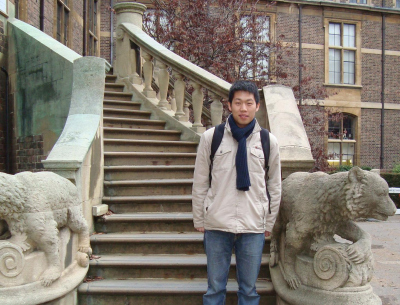Die Inhalte dieser Seite sind leider nicht auf Deutsch verfügbar.
Seitenpfad:
- Graduate School GLOMAR
- PhD student reports
- Research Placements
- Enqing Huang
Enqing Huang
Enqing Huang’s report on his second research stay at the Department of Earth Sciences, University of Cambridge from 19 December 2011 – 6 January 2012
There is an increasing interest in the topic of deep sea ventilation during the Last Glacial Maximum. The deep ocean is a much larger carbon reservoir compared to the atmosphere. More and more scientists believe that the glacial lower atmospheric CO2 is at least partly induced by weakened deep ocean ventilation and an increase in the carbon storage in the ocean interior during that time. Dr. Luke Skinner of the University of Cambridge and me are working together on this topic at the present. We analyze radiocarbon ages of co‐existing planktonic and benthic foraminifera from deep-sea sediments to estimate glacial ventilation rates of deep oceans.
During Sep.-Nov. 2011 I paid my first visit to Cambridge. There I worked in the radiocarbon laboratory with Dr. Skinner to graphitize radiocarbon samples of foraminifera. As the graphitization of the first batch of 90 samples was accomplished very successfully, I decided to pay a second visit to Cambridge to graphitize another batch of 50 samples. Dr. Skinner was willing to open his laboratory to me during the Christmas vacation of 2011.
As what I have done during my first visit, I weighed and cleaned foraminiferal samples which had been prepared in advance in Bremen. The foraminiferal samples were subsequently hydrolysed to CO2. The CO2 was further reduced to graphite in a hydrogen/iron catalyst system at high temperature of 600°C. The graphitized samples were finally sent to the accelerator mass spectrometry (AMS) 14C lab at the Australian National University for measurement. So far we have received the first part of analyzing results. A few duplicated samples show strong consistent results. This demonstrates that the graphitization step was conducted very well in Cambridge. The possible carbon isotope fractionation was reduced to an acceptable level. We still need time to interpret the scientific significance of the data, however, a first impression of the results make us believe that they shed light on some aspects of the glacial deep ocean ventilation.
Although working over the Christmas vacation makes me feel a little lonely, the excitement of working at this famous university and working on this valuable research topic makes a good compensation. My Ph.D. program benefits a lot through working with Dr. Luke Skinner and my two research stay in Cambridge. I really appreciate GLOMAR for its generous support.
During Sep.-Nov. 2011 I paid my first visit to Cambridge. There I worked in the radiocarbon laboratory with Dr. Skinner to graphitize radiocarbon samples of foraminifera. As the graphitization of the first batch of 90 samples was accomplished very successfully, I decided to pay a second visit to Cambridge to graphitize another batch of 50 samples. Dr. Skinner was willing to open his laboratory to me during the Christmas vacation of 2011.
As what I have done during my first visit, I weighed and cleaned foraminiferal samples which had been prepared in advance in Bremen. The foraminiferal samples were subsequently hydrolysed to CO2. The CO2 was further reduced to graphite in a hydrogen/iron catalyst system at high temperature of 600°C. The graphitized samples were finally sent to the accelerator mass spectrometry (AMS) 14C lab at the Australian National University for measurement. So far we have received the first part of analyzing results. A few duplicated samples show strong consistent results. This demonstrates that the graphitization step was conducted very well in Cambridge. The possible carbon isotope fractionation was reduced to an acceptable level. We still need time to interpret the scientific significance of the data, however, a first impression of the results make us believe that they shed light on some aspects of the glacial deep ocean ventilation.
Although working over the Christmas vacation makes me feel a little lonely, the excitement of working at this famous university and working on this valuable research topic makes a good compensation. My Ph.D. program benefits a lot through working with Dr. Luke Skinner and my two research stay in Cambridge. I really appreciate GLOMAR for its generous support.



